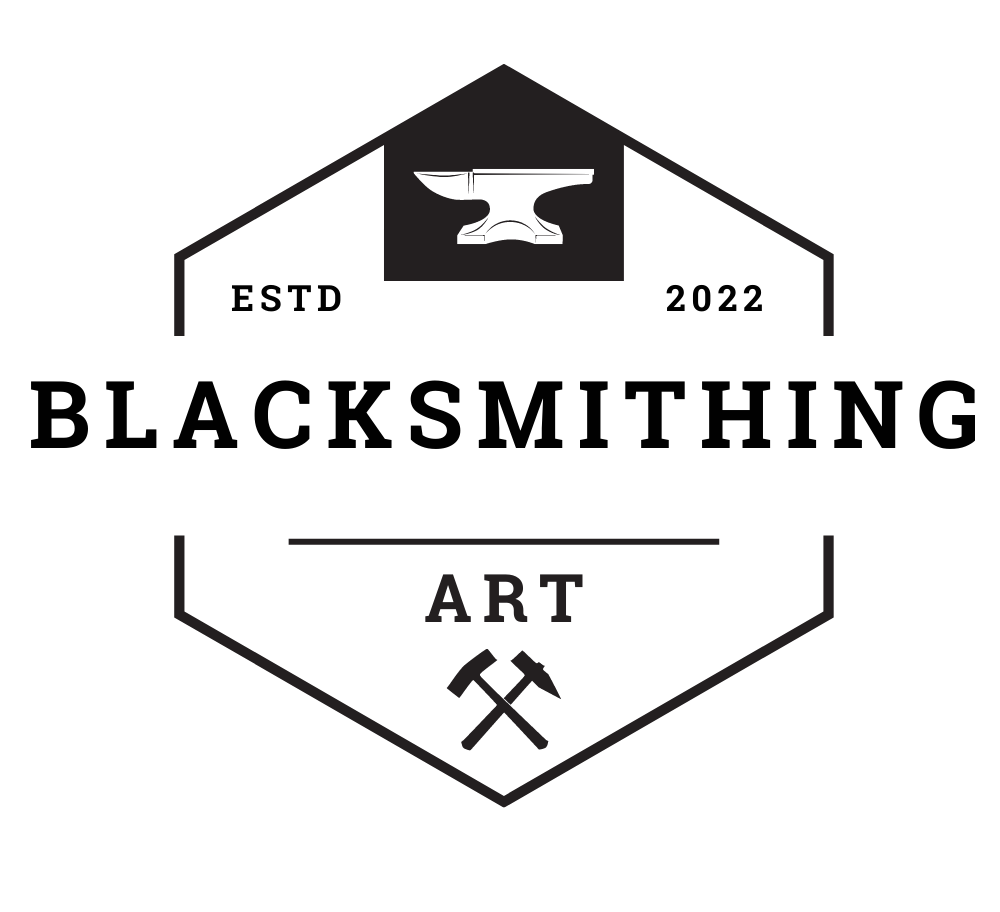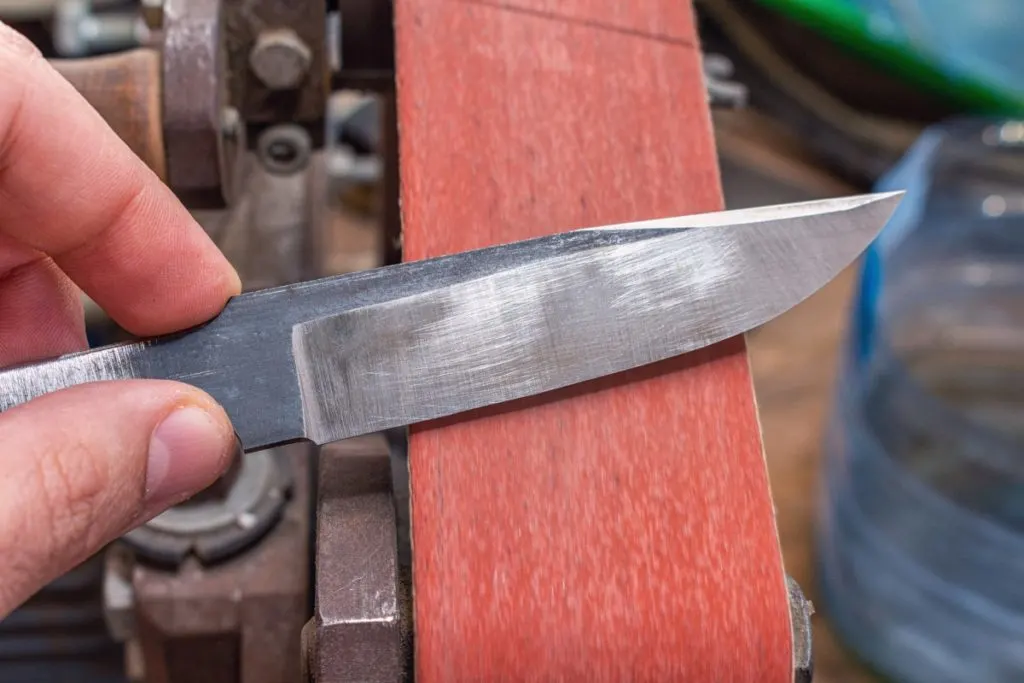If you don’t understand the value of a sharp knife, you probably use a dull one more frequently than you would admit. Slices of cucumber may not require a razor-sharp knife’s blade. However, you could run into issues while carving a cooked turkey with a dull knife.
But how can it be sharpened? While there are other ways to sharpen it, sandpaper is by far the easiest and the most common. If you don’t know how to sharpen your blade with sandpaper, this article will provide the information you need.

Contents
- 1 How to sharpen kitchen knives with sandpaper in the most reliable way
- 2 How to sharpen a pocket knife with sandpaper in the easiest way
- 3 What does the mouse pad trick mean in knife sharpening?
- 4 Tips for creating your own DIY knife sharpening kit with sandpaper
- 5 Tips for keeping your knife sharp for long
- 6 Precautions you should take care of
- 7 Frequently asked questions
- 8 Conclusion
How to sharpen kitchen knives with sandpaper in the most reliable way
This trick – which is to create your own DIY knife sharpening kit – is the recommended sharpening method for kitchen knives. Here are 5 steps you should take during this procedure to make a knife sharpening kit with no need of buying pricey sharpening stones.
Step 1
Do this in a wind-free, somewhat clean place. It can be a restroom, for instance.
Clean the tiles first with your microfiber rag and a tiny drop of acetone.
You want to make them spotless and fuzzy-free.
Spend a few minutes letting the acetone clean the bathroom tiles.
Step 2
Make a spot where the spray adhesive can go. The bathroom tiles and the sandpaper sheet should both be sprayed with spray adhesive on the back before being fastened together.
Step 3
After attaching sandpaper to the tile, remove the remaining spray adhesive from the tile with acetone-soaked cotton as soon as possible. Then put something over it that won’t stick to spray adhesive, like wax paper, or plastic. Press the sandpaper sheets against the tile with a large flat weight, and allow it to sit and dry.
Step 4
Repeat steps 2 and 3 with each new set of sandpaper sheets you use. Before using these sharpening tiles to sharpen your kitchen knives, give the spray adhesive an hour or two to cure. Mark each sharpening tile with a sharpie.
Step 5
So that you can stack the tiles without worrying about tearing the sandpaper sheets, we suggest placing some of those tiny rubber bumpers on the bottom of the tiles. Besides, it makes it simpler to sharpen knives without the sharpening tile moving.
Additionally, we found it more convenient to have the sandpaper flush with the edge of the tiles and to have the excess sandpaper cut off from the tiles while using this knife sharpening kit.
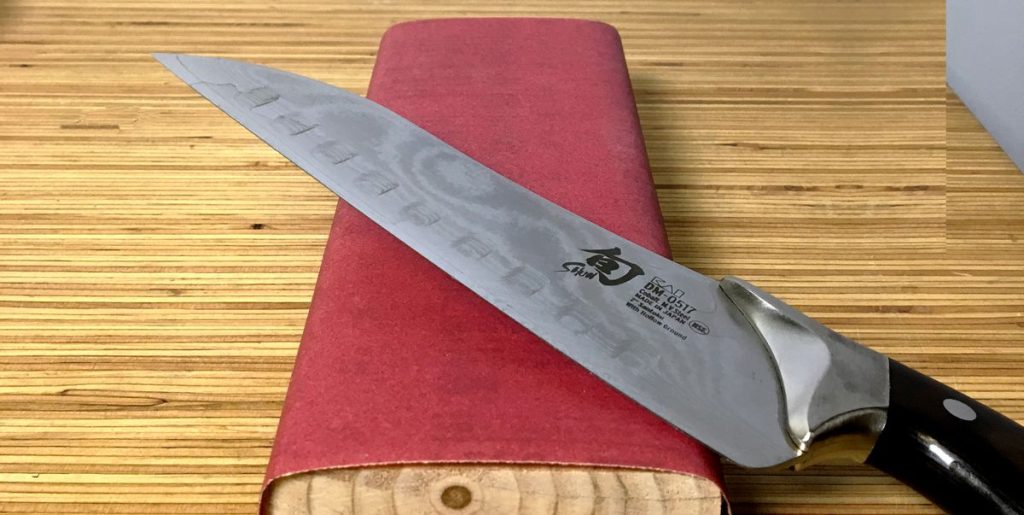
How to sharpen a pocket knife with sandpaper in the easiest way
If you’re looking for a cheap DIY method to improve the blade of your pocket knife, there are methods to sharpen it using everyday items like sandpaper.
A pocket knife may be sharpened in a variety of ways using sandpaper, and here is one sharpening system you can try with these 5 easy steps.
Step 1
You should make sure your pocket knife is clean before you begin. You can do this by cleaning it with a soapy water solution or wiping it down with a wet cloth.
Step 2
Make sure you have a grit size that is suitable for your pocket knife before you start. You should use different grit sizes, such as 800, 1000, and 2000.
You should also keep your sandpaper damp with water for the best results.
Step 3
To ensure that you keep a uniform sharpening angle, you should use a crock stick or an angle guide. But you shouldn’t ever switch up your angles. This might result in jagged edges.
You might want to mark the bevel on your edge with a permanent marker. Similarly, you can test the sharpness of your edge on a piece of paper.
Apply light to medium pressure. You run the risk of ruining the edge if you press too much.
Step 4
Start by holding your pocket knife at an angle of around 10 degrees. The type of knife you are sharpening determines the sharpening angle. Compared to chef knives, pocket knives require a greater cutting angle.
Step 5
Clean the edge of your pocket knife after sharpening it with sandpaper. To keep metal or dust from getting in your eyes, wear safety glasses. As an alternative, you could use a cotton cloth and a degreasing solution.
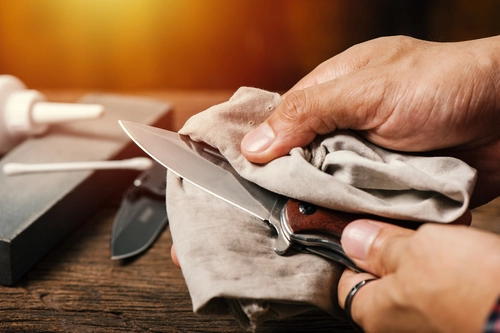
What does the mouse pad trick mean in knife sharpening?
To sharpen knives, some people use mouse pads and sandpaper instead of a knife sharpener or sharpening stones. On the flat surface, they set the mouse pad and the blade. Cut the corners of the mouse pad while the sandpaper is still on.
It is claimed that this approach produces better results than using just sand paper.
You should employ a stropping motion with the shiv to use this homemade sharpening equipment.
To achieve this, just adhere to the given instructions.
Tips for creating your own DIY knife sharpening kit with sandpaper
Making your own DIY knife sharpening kit instead of buying a sharpening stone is a great way of sharpening your blade as well as saving some money. But creating a DIY knife sharpening kit isn’t easy. That is why we provide you with these tips:
- The sandpaper should be given a few drops of water.
Before beginning, add a few drops of water to the sand paper. As a result, the blade slides more easily and the edge stays cool. When finished, rinse the paper and blade.
- Initially, use coarse grits.
To begin sharpening, use sandpaper with coarse grit. It will assist in removing the dull edge and resharpening the blade.
- Use a higher grit sandpaper later.
Once you’ve used coarse-grit sandpaper to remove the dull edge, move to a higher grit. The blade will become more polished and have a sharper edge.
- Try the mouse pad technique.
If you’re having difficulties holding the blade stationary during sharpening, try using this method. Put the sandpaper on top of the mouse pad and place it on a sturdy surface. Sharpening will be simpler and the sandpaper will remain still.
- Apply a gentle hand.
Avoid using excessive pressure. Make sure the entire blade is in contact with the sandpaper while using a gentle touch. It will lessen the chance of the knife getting hurt.
- Add a polishing compound to the end.
Finish with a polishing agent like WD-40 or mineral oil to give the blade an even sharper edge. It will have a nice shine and any scratches will be removed.
Tips for keeping your knife sharp for long
You know how to use sandpaper to sharpen your blade, but do you know how to keep it sharp for a long time? Sharpening a knife is a laborious and time-consuming process.
Because of this, you must ensure that the sharpness will remain after considerable effort.
Here are some crucial pointers for keeping your knife sharp:
- Never wash a knife in a dishwasher. Dishwasher detergent is abrasive, which can reduce the effectiveness of the blade. Instead, use hot water and dish soap to wash and scrub it. After that, let it thoroughly dry before storing it.
- Use a cutting board. A hard surface is your sharp knife’s worst enemy. Your knife could quickly become dull from it. As a result, if you want to keep the blade sharp, always use a cutting board.
- The knife should never be kept in the kitchen with other tools. To keep your blade sharp, it has to be handled with care. Do not keep it in the same drawer as tongs, whisks, or spoons. To keep the blades safe, use a magnetic knife strip or a knife block.
Precautions you should take care of
You must finish a few tasks and exercise caution before sharpening your knife using any of the techniques mentioned above:
- Clean the blade by wiping away dirt and debris with water and a dry cloth or dish soap. If the blade is very dirty, scrub the dirt off with a scrub brush or sponge.
- Wear gloves when sharpening your knife with sandpaper as a safety precaution. You’ll want to maintain a tight grip on your pocket knife because some of these techniques require you not to attach sandpaper to anything.
- Cut or sharpen your pocket knife away from your body to lessen the possibility of inadvertently stabbing yourself or into yourself. Keep the blade out of the sandpaper to avoid cutting it and extend the life of the material.
- Wear safety glasses. This is another precaution you might wish to take is to wear safety glasses to prevent dust or metal chips from getting into your eyes and hurting them.
- Work outside or in a well-ventilated area. Dust, fumes, and other particles may be produced during sharpening, so make sure the area is well-ventilated. To finish the procedure, look for a space with good ventilation, or sharpen your pocketknife outside.
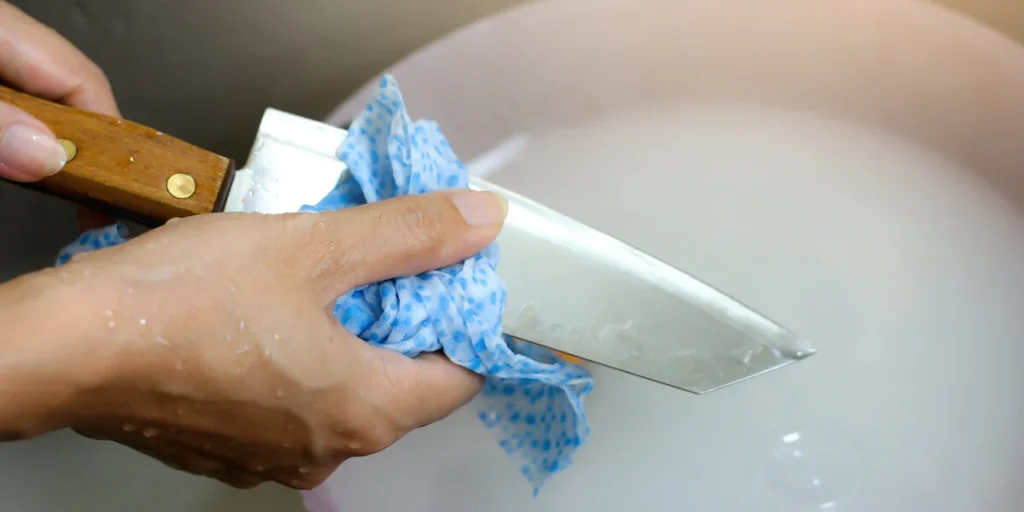
Frequently asked questions
Can you sharpen knives with sandpaper?
If you use the appropriate sandpaper grit number and the right knife sharpening technique, you can use sandpaper for creating a knife sharpening kit.
You can make sharp knives for less money and with far more accessibility by using sand paper instead of conventional sharpening stones. In a survival situation or emergency, knowing the full sharpening process is a wonderful ability to have.
What grit sandpaper should I use to sharpen a knife?
Sandpapers have a variety of sharp edge types that may be used while sharpening knives and other objects.
Sandpaper can be measured according to the sandpaper grit number. It measures how many sharp edges there are per square inch. The higher the grit sandpaper (and the higher the grit size), the finer sanding.
Depending on the kind of knife you are sharpening, you need to choose the appropriate sandpaper. Here are some different types of sandpaper you can use for knife sharpening:
Coarse grit sandpaper
Sandpapers with a coarse grit range in size from 220 to 320 grit. It works well for eliminating a lot of material and smoothing out burrs.
Additionally, this sand paper grit is frequently used to quickly remove a layer of finish or dirt. The capacity of the coarse grit to swiftly take down the blade’s edge is one of its strengths.
Medium grit sandpaper
Sand paper with a medium grain is typically 600 grit. For eliminating scuffs from coarse grit sandpaper, it is the ideal grit. Commonly, other people sand raw wood with this sandpaper to remove varnish and final finish and get it ready for staining or painting. It may also be used to smooth the edge of the blade and remove minor burrs.
Fine grit sandpaper
Sandpaper with fine grit is typically between 1000 and 1500 grit. It is the finest grit sandpaper available for use in sharpening knives.
To get rid of water stains on wood and prepare the surface for a sealer, people often use fine grit. Additionally, it may be used to polish the knife blade’s edge and take care of any tiny dings.
High grit sandpaper
High-grit sandpaper is typically between 2000 and 2500 grit. The edge of the knife blade may be polished using this kind of sand paper. It aids in polishing and removing any imperfections.
Can you sharpen a knife with 1000-grit sandpaper?
Yes, you can.
A knife with a chipped edge can be sharpened with grit less than 1000. Additionally, the best grit for making a dull knife sharp is between 1000 and 3000 grit. As it was mentioned above, this sandpaper sheet belongs in the categories of fine and high grit.
What is the best thing to sharpen a knife with?
There’s a whetstone, sandpaper, a knife sharpener, a sharpening stone, a sharpening tile, even a DIY knife sharpening kit you can make yourself, and many other tools that can help you with a straight razor, a pocket knife, or a usual dull knife sharpening.
Every one of them has its advantages and disadvantages. However, when using a whetstone, a rectangular block that functions much like sandpaper and helps to straighten and polish the cutting edge of the blade as you run the knife across it, is our preferred method for sharpening blades.
Most whetstones are intended to be soaked in water before each usage. If your whetstone has to be wet, immerse it in water for five to ten minutes, or until no bubbles are coming to the surface. To use it, carefully rub each side of the knife on the whetstone a few times while holding the knife at a 20-degree angle.
If your knife is very dull, start with the coarse side of the whetstone and then repeat the process on the fine-grind side. Most whetstones include both a coarse-grind side and a fine-grind side.
You can jump right to the fine-grind side if you already consistently hone and sharpen your knife once a year. While using the whetstone, if it seems to be drying off, simply apply some more water and keep going.
Conclusion
Sandpaper can be used to sharpen a variety of blades, including a kitchen knife and a pocket knife, though it might not be as effective as whetstones. All people who use knives have access to and can afford sandpaper, which can be used to sharpen the edges.
Sharpening your knife with sandpaper, or even creating your knife sharpening kit, will not only guarantee your kitchen or pocket knife becoming sharp but also will save you money and provide you with a great way of constantly keeping your knives in a good state.
It is crucial to choose the proper grit size before you start sharpening. Otherwise, you run the danger of total blade ruin. That is why we hope that this article has helped you to learn more about numerous techniques and tips like these that you can try!
Read More About How to Sharpen Kitchen Knives with Sandpaper
